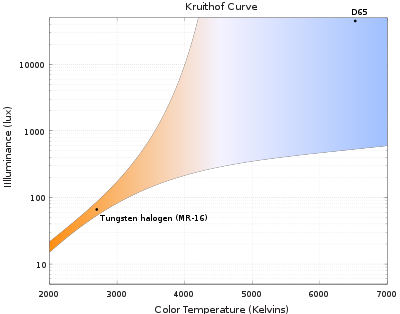
Kruithof curve
Encyclopedia

Arie Andries Kruithof
Arie Andries Kruithof was a Dutch professor of applied physics at Eindhoven University of Technology ....
, the Kruithof curve relates the illuminance
Illuminance
In photometry, illuminance is the total luminous flux incident on a surface, per unit area. It is a measure of the intensity of the incident light, wavelength-weighted by the luminosity function to correlate with human brightness perception. Similarly, luminous emittance is the luminous flux per...
and colour temperature of visually pleasing light sources. Lighting conditions lying inside the bounded region were empirically assessed as being pleasing, whereas conditions outside the region were displeasing.
The colour sensation of a given light mixture may vary with absolute luminosity
Luminosity
Luminosity is a measurement of brightness.-In photometry and color imaging:In photometry, luminosity is sometimes incorrectly used to refer to luminance, which is the density of luminous intensity in a given direction. The SI unit for luminance is candela per square metre.The luminosity function...
, because both rods and cones are active at once in the eye, with each having different colour curves, and rods taking over gradually from cones as the brightness of the scene is reduced. This means, for example, that light with a colour temperature of 6000 K
Kelvin
The kelvin is a unit of measurement for temperature. It is one of the seven base units in the International System of Units and is assigned the unit symbol K. The Kelvin scale is an absolute, thermodynamic temperature scale using as its null point absolute zero, the temperature at which all...
may appear white under high luminance
Luminance
Luminance is a photometric measure of the luminous intensity per unit area of light travelling in a given direction. It describes the amount of light that passes through or is emitted from a particular area, and falls within a given solid angle. The SI unit for luminance is candela per square...
, but appear bluish under low luminance. Under the same low luminance conditions, the colour temperature may need to be adjusted to, say, 4700 K, to appear white. This effect leads to a change in colour rendition with absolute illumination levels that can be summarised in the empirical
Empirical
The word empirical denotes information gained by means of observation or experimentation. Empirical data are data produced by an experiment or observation....
Kruithof curve.
As the brightness of the scene decreases, the brightness of red colours decreases more rapidly than those of blue colours, this being the Purkinje effect
Purkinje effect
The Purkinje effect is the tendency for the peak luminance sensitivity of the human eye to shift toward the blue end of the color spectrum at low illumination levels.This effect introduces a difference in color contrast under different levels of...
.
Further reading
(A study in which the average luminance was 8 cdCandela
The candela is the SI base unit of luminous intensity; that is, power emitted by a light source in a particular direction, weighted by the luminosity function . A common candle emits light with a luminous intensity of roughly one candela...
/m2, or the illumination 200–400 lux
Lux
The lux is the SI unit of illuminance and luminous emittance, measuring luminous flux per unit area. It is used in photometry as a measure of the intensity, as perceived by the human eye, of light that hits or passes through a surface...
, with an average of about 330 lux.)
External links
- Daylight: Is it in the eye of the beholder? by Kevin P. McGuire.

